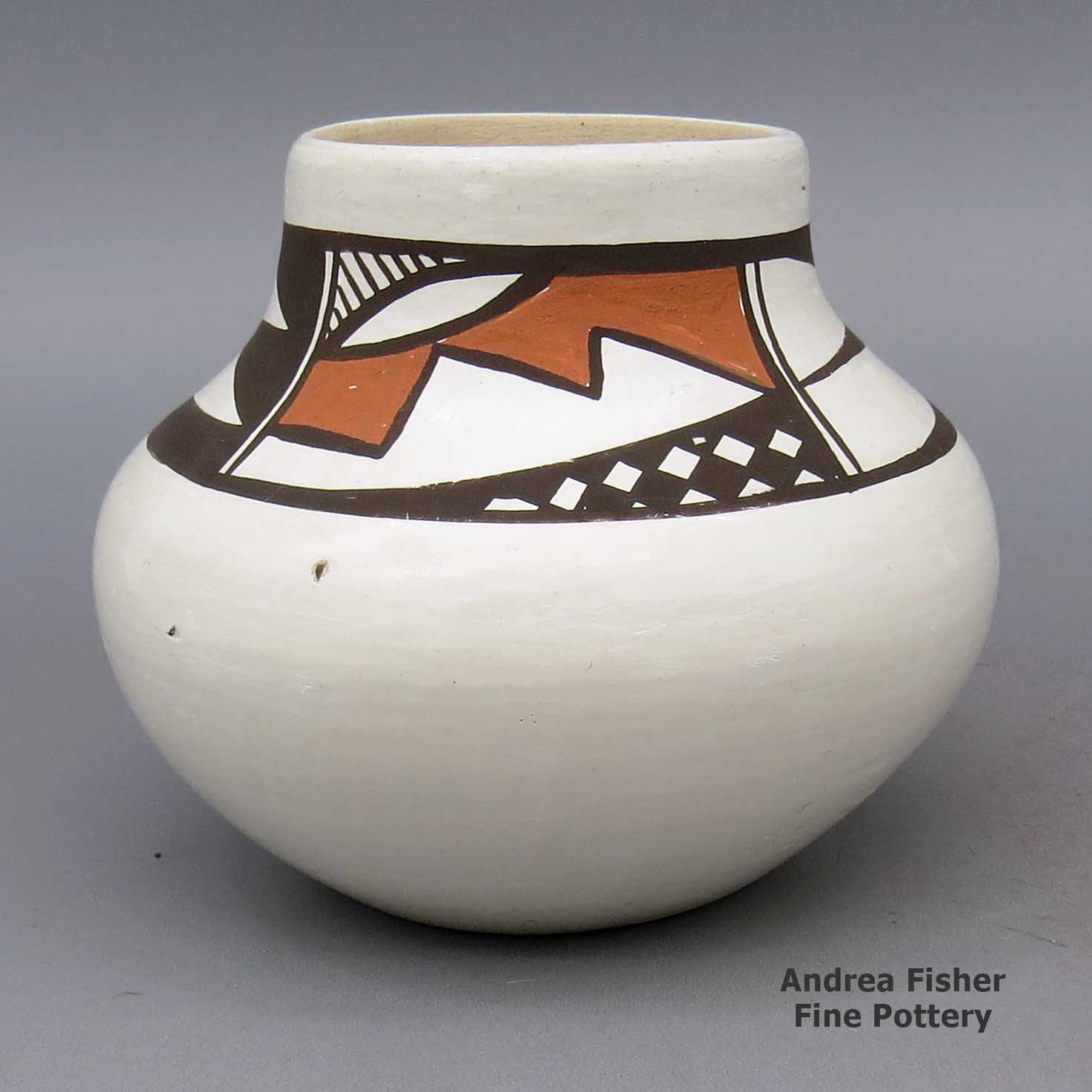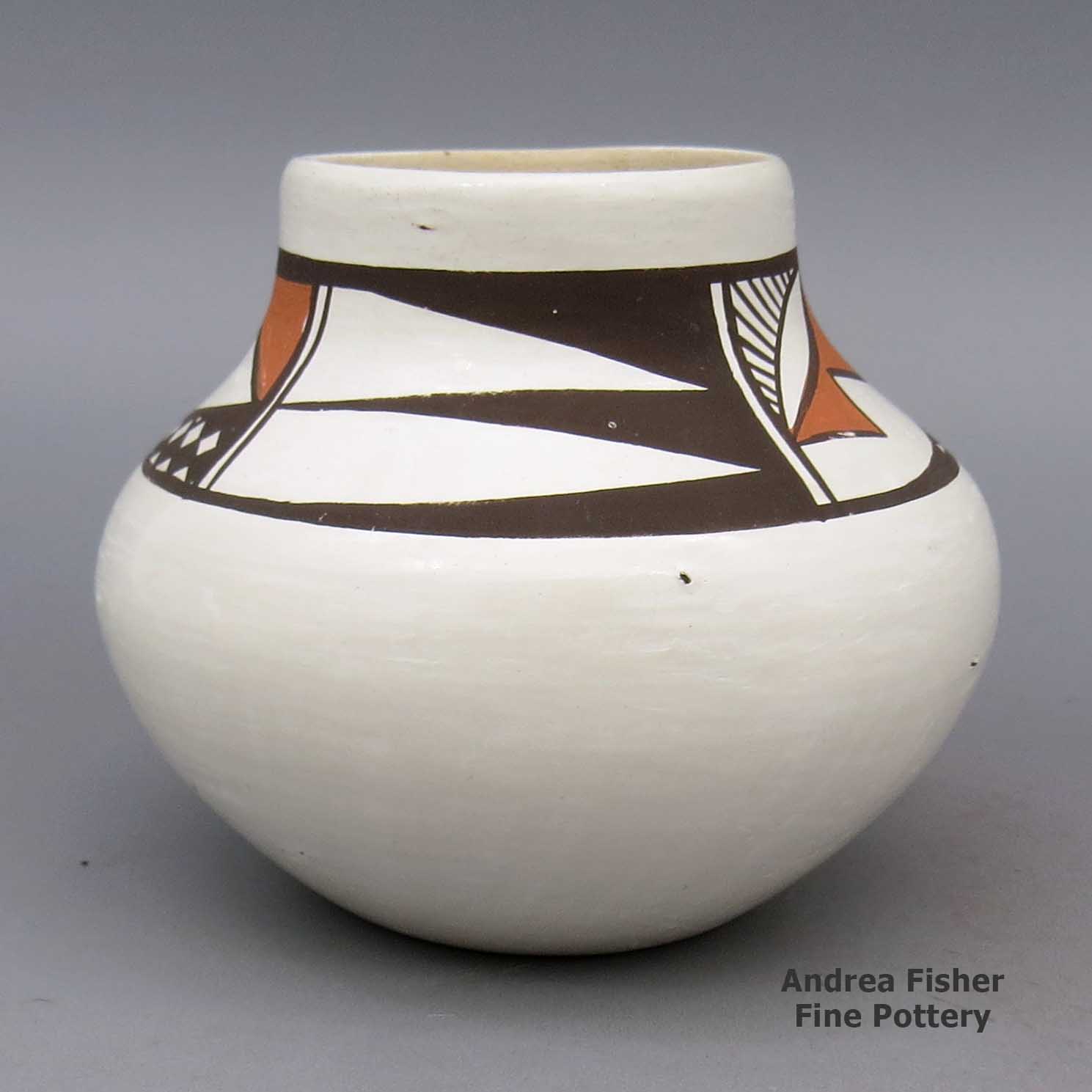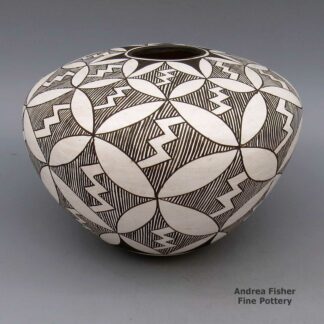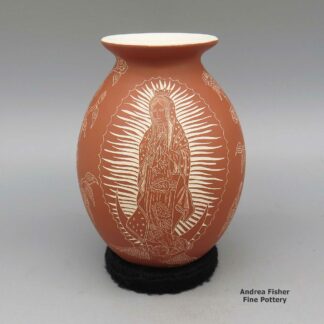| Dimensions | 3.5 × 3.5 × 3 in |
|---|---|
| Condition of Piece | Very good, has some pitting |
| Date Born | 1978 |
| Signature | Stella Teller Isleta, N.M. |
Stella Teller, cmle2l089, Polychrome jar with geometric design
$275.00
A small polychrome jar decorated with a four-panel checkerboard and geometric design
In stock
Brand
Teller, Stella
Stella's pieces are notable for their "sleeping eyes," overall light-blue to white coloring and often have strings of heishi beads either inlaid or painted on. Some of her pieces have found their way into the collections of the Peabody Museum at Harvard College in Boston, the Folk Museum in Berlin, Germany, and into the Wright Collection, Walton-Anderson Collection and the personal collections of Frank Kinsel and Peter B. Carl.
Her favorite designs include clouds, rain, turtles, Pueblo dancers and kiva steps. Her favorite styles include storytellers, Nativities, jars, bowls, wedding vases, canteens and effigies.
Stella has passed her knowledge on to her daughters: Chris, Mona, Robin and Lynette, each of whom has gone on to become an award-earning potter in their own right.
A Short History of Isleta Pueblo
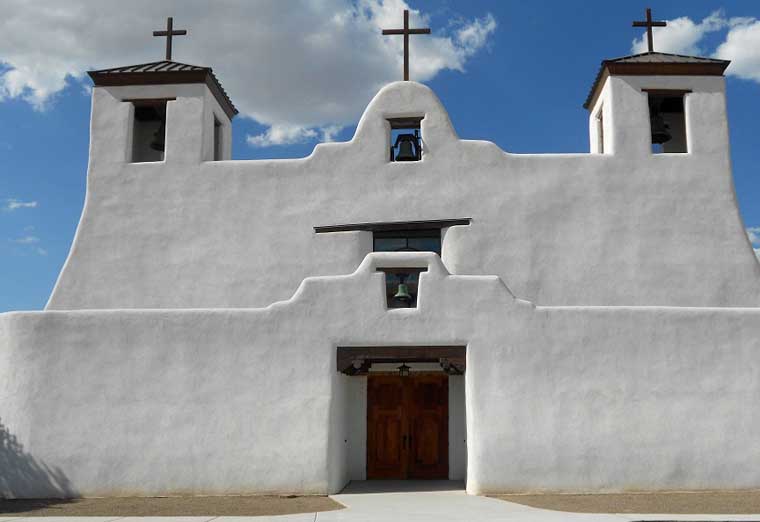
Isleta Pueblo was founded in the 1300s. Archaeologists have put forth various ideas as to where the people came from with some scholars saying they migrated north from Mogollon/Mimbres settlements to the south while others say they migrated southeastward from either Chaco Canyon in the 1100s and 1200s or from the Four Corners area in the 1200s and 1300s. There is every possibility they are an indigenous Tano population that was merged with Aztec migrants coming north from central Mexico and they were never part of the Chacoan world. Their Tiwa language is shared with nearby Sandia Pueblo and a very similar tongue is spoken to the north at Taos and Picuris Pueblos. The two dialects are sometimes referred to as Southern and Northern Tiwa. The Taos people also consider that some of their ancestors migrated north from Aztec lands long ago while others came from the north.
When the Spanish arrived in the area they named the pueblo "Isleta" (meaning: island). The residents were relatively accommodating to the Spanish priests when compared to the reception the same priests got in other areas of Nuevo Mexico (making Isleta something of an "island of safety" for the Spanish in an ocean of hostility). When the Pueblo Revolt of 1680 happened, Isleta either couldn't or wouldn't participate in the rebellion.
When the Spanish governor was evicted from Santa Fe he went to Albuquerque, then to Isleta and gathered his troops. With warriors from the northern pueblos harassing their every move, none of the Spaniards wanted to go back and fight so when they left Isleta and headed south, many Isletans went south to the El Paso area with them. Those who went south were allowed to establish their own pueblo at Ysleta del Sur, a place that at the time was beyond the boundaries of the village of El Paso.
Other Isletans fled to the Hopi settlements in Arizona and returned after the fighting was clearly over, many with Hopi spouses. When the Spanish returned in 1682 they found the Isleta mission church burned and the main structure was being used as a livestock pen. When Don Diego de Vargas came in 1692 with troops intent on reconquering New Mexico, they found the whole village of Isleta empty and burned.
The governor ordered the pueblo be rebuilt and resettled so residents were brought in from Taos and Picuris to the north and from Ysleta del Sur to the south. By 1720 a new, more grandiose mission had been built on the foundations of the first.
Over the next century some dissident members of the Laguna and Acoma Pueblo communities migrated to Isleta. While they were welcomed into the main Isleta pueblo at first, friction developed over the years until in the late 1800s, the small communities of Oraibi and Chicale were established. Most of the newcomers moved to one or the other but some returned to Acoma and Laguna.
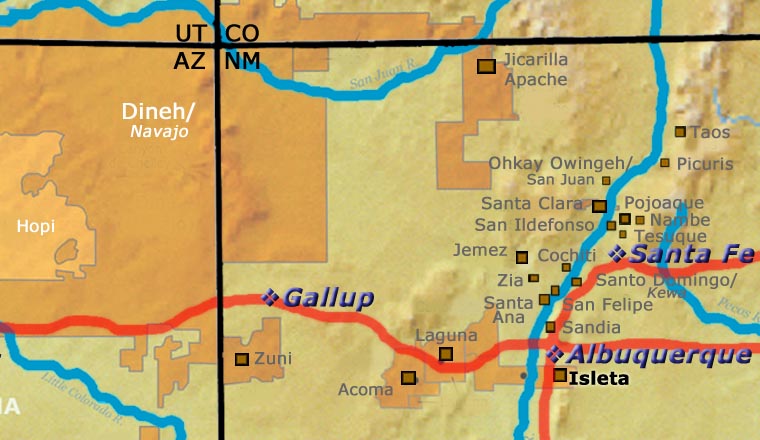
For more info:
Pueblo of Isleta at Wikipedia
Pueblo of Isleta official website
About Jars
The jar is a basic utilitarian shape, a container generally for cooking food, storing grain or for carrying and storing water. The jar's outer surface is a canvas where potters have been expressing their religious visions and stories for centuries.
In Sinagua pueblos (in northern Arizona), the people made very large jars and buried them up to their openings in the floors of the hidden-most rooms in their pueblo. They kept those jars filled with water but also kept smaller jars of meat and other perishables inside those jars in the water. It's a form of refrigeration still in use among indigenous people around the world.
Where bowls tend to be low, wide and with large openings, jars tend to be more globular: taller, less wide and with smaller openings.
For a potter looking at decorating her piece, bowls are often decorated inside and out while most jars are decorated only on the outside. Jars have a natural continuity to their design surface where bowls have a natural break at the rim, effectively yielding two design surfaces on which separate or complimentary stories can be told.
Before the mid-1800s, storage jars tended to be quite large. Cooking jars and water jars varied in size depending on how many people they were designed to serve. Then came American traders with enameled metal cookware, ceramic dishes and metal eating utensils...Some pueblos embraced those traders immediately while others took several generations to let them and their innovations in. Either way, opening those doors led to the virtual collapse of utilitarian pottery-making in most pueblos by the early 1900s.
In the 1920s there was a marked shift away from the machinations of individual traders and more toward marketing Native American pottery as an artform. Maria Martinez was becoming known through her exhibitions at various major industrial fairs around the country and Nampeyo of Hano was demonstrating her art for the Fred Harvey Company at the Grand Canyon. The first few years of the Santa Fe Indian Market helped to solidify that movement and propel it forward. It took another couple generations of artists to open other venues for their art across the country and turn Native American art into the phenomenon it has become.
Today's jars are artwork, not at all for utilitarian purposes, and their shapes, sizes and decorations have evolved to reflect that shift.
About Geometric Designs
"Geometric design" is a catch-all term. Yes, we use it to denote some kind of geometric design but that can include everything from symbols, icons and designs from ancient rock art to lace and calico patterns imported by early European pioneers to geometric patterns from digital computer art. In some pueblos, the symbols and patterns denoting mountains, forest, wildlife, birds and other elements sometimes look more like computer art that has little-to-no resemblance to what we have been told they symbolize. Some are built-up layers of patterns, too, each with its own meaning.
"Checkerboard" is a geometric design but a simple black-and-white checkerboard can be interpreted as clouds or stars in the sky, a stormy night, falling rain or snow, corn in the field, kernels of corn on the cob and a host of other things. It all depends on the context it is used in, and it can have several meanings in that context at the same time. Depending on how the colored squares are filled in, various basket weave patterns can easily be made, too.
"Cuadrillos" is a term from Mata Ortiz. It denotes a checkerboard-like design using tiny squares filled in with paints to construct larger patterns.
"Kiva step" is a stepped geometric design pattern denoting a path into the spiritual dimension of the kiva. "Spiral mesa" is a similar pattern, although easily interpreted with other meanings, too. The Dineh have a similar "cloud terrace" pattern.
That said, "geometric designs" proliferated on Puebloan pottery after the Spanish, Mexican and American settlers arrived with their European-made (or influenced) fabrics and ceramics. The newcomers' dinner dishes and printed fabrics contributed much material to the pueblo potters design palette, so much and for so long that many of those imported designs and patterns are considered "traditional" now.
Teller Family Tree - Isleta Pueblo
Disclaimer: This "family tree" is a best effort on our part to determine who the potters are in this family and arrange them in a generational order. The general information available is questionable so we have tried to show each of these diagrams to living members of each family to get their input and approval, too. This diagram is subject to change should we get better info.
- Marcellina Jojola (c. 1860s-)
- Emily Lente Carpio (c. 1880s-)
- Felecita Jojola (c. 1900s-) & Rudy Jojola
- Stella Teller (1929-) and Louis Teller
- Chris Teller Lucero (1956-)
- Marie (Robin) Teller Velardez (1954-) and Ray Velardez
- Lesley Teller Velardez (1973-)
- Mona Blythe Teller (1960-)
- Christopher Teller
- Nicol Teller Blythe (1978-)
- Lynette Teller (1963-)
- Stella Teller (1929-) and Louis Teller
- Felecita Jojola (c. 1900s-) & Rudy Jojola


